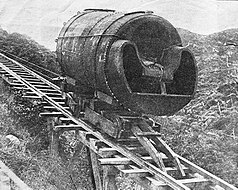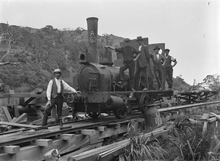Piha Tramway
| Piha Tramway | |||||||||||||||||||||||||||||||||||||||||||||||||||||
|---|---|---|---|---|---|---|---|---|---|---|---|---|---|---|---|---|---|---|---|---|---|---|---|---|---|---|---|---|---|---|---|---|---|---|---|---|---|---|---|---|---|---|---|---|---|---|---|---|---|---|---|---|---|
|
| |||||||||||||||||||||||||||||||||||||||||||||||||||||
| Gauge : | 914 mm ( English 3-foot track ) | ||||||||||||||||||||||||||||||||||||||||||||||||||||
| Maximum slope : | 220 and 400 ‰ | ||||||||||||||||||||||||||||||||||||||||||||||||||||
Cable railway - (blue) and narrow-gauge railway stretch (pink)
|
|||||||||||||||||||||||||||||||||||||||||||||||||||||
The Piha Tramway was a forest railway in New Zealand operated from 1906 to 1921 with a gauge of 3 feet (914 mm), the steepest sections of which were operated as funicular railways via steam-powered winches.
Route
During the deforestation of the Kauri forests in the Piha area , the tree trunks had to be brought to the sawmill in Karekare , eight kilometers away , and the sawn timber had to be brought eight kilometers along the coast to Whitipu, where it could be loaded onto ships.
In the beginning the wood was dragged from carts of oxen or horses at low tide on the beach to Whatipu. Around 1906, Dr. Raynor, a Canadian-born dentist who worked in Auckland, at William Stokes' financially troubled logging company. Together they built a sawmill and a steam-powered forest railway . The wood was brought from the Piha Valley via a 1: 4.5 (22%) steep funicular first 300 meters up to the steam-powered sawmill and then via a 1: 2.5 (40%) steep funicular over a total distance of about 8 Kilometers to Karekare Beach .
Over time, the forest railway was initially extended north to bring tribes from the nearby Anawhata Valley to Piha. Later, an approximately 8 km long narrow-gauge line was built in the south , which followed the route of another previously built forest railway. It led from Karekare along the Tasman Sea to Whitipu , where a new jetty had been built at the entrance to Manukau Harbor on the side protected by Paratuate Island.
For the narrow-gauge 3-foot (914 mm) gauge, steel rails weighing 7-14 kg / m per meter were laid on 125 × 50 mm (5 × 2 inch) wooden sleepers. Much of the railway line along the Tasman Sea was of primitive quality. She crossed soft sandy beaches just a few meters above sea level and made her way along rocky outcrops and often past steep cliffs. Along the cliffs, where there was no natural route for the route, holes were drilled in the rock, in which the railway sleepers were fixed.
Both construction and operation were affected by the notorious west coast weather: storms, torrential rain, wind and sand blowing over the tracks. Crossing Karekare Beach itself proved difficult. The sand was hard in some areas and soft in others. Some primitive trestle bridges up to 5 m high were built where the cliffs were interrupted at river mouths or sea bays. A tunnel was built whose clearance profile was so tight that the hinged chimney of the steam locomotive had to be tilted into a horizontal position in order to let it pass.
business
The funicular was already a mile (1.6 km) long in December 1910 and was believed to be the steepest route in the world at the time. On this part of the route, a rope had to be hung from the winch at the back of the car before it descended the steep stretch. This reduced the downward speed.
During the construction of the sawmill in Karekare Bush, the machines were also transported on the funicular, which has proven extremely difficult. All parts of the system had to be transported with the forest railway, which had a gradient of 1: 1 (45 °) in several places. Moving a 10-ton steam boiler across the line was no easy feat, and it speaks to the persistence and ingenuity of the New Zealand Bushman that the boiler was able to be brought into place in December 1910 except for a minor derailment without major breakdowns, one Task that took several days.
In 1915 the forest enterprise and the forest railway were nationalized. The railroad was then bought by NZ Government Railways, which needed wood for their own use. Timber shipping ended when there were few kauri trees left and the hills suffered from the effects of logging. The forest railway was abandoned in 1921 and its remains were left to decay.
Locomotives
A small Bagnall steam locomotive named "Sandfly" was used on the route from the lower end of the funicular at Karekare to the quay at Whatipu.
Another steam locomotive was delivered in parts in 1914 and assembled at the jetty for use on the Piha Tramway. The A 62 locomotive was built by Dubs in 1873 (manufacturer no. 656/73) and put into operation in Christchurch and Timaru in January 1875 . It was shipped to Wellington in 1897 and loaned to the New Zealand Railways Maintenance Branch six years later for use in the Pencarrow Quarry , Wellington, and purchased by the Maintenance Branch in 1906. In 1914 it was used on the route between Piha and Whatipu and five years later it returned to the Newmarket workshops for shunting work. In 1921 it was loaned from a sawmill near Rotorua and finally decommissioned in 1926. It was then exhibited in the Otahuhu workshops .
Individual evidence
- ↑ a b c d e f g Paul and Rebecca da Rezzo: The Piha Tramway - Piha, Karekare and Whatipu. September 30, 2016. Retrieved April 22, 2018.
- ^ A b Wallace Badham: The Iron-Bound Coast: Karekare in the Early Years. Oratia Media Ltd, 2009. pp. 51-59.
- ↑ a b A big undertaking: hauling a boiler up the inclined tramway at Piha. Auckland Weekly News, December 29, 1910.
- ^ Erecting a locomotive, Piha. Steam locomotive “A” class no. 62 (0-4-0T type). Alexander Turnbull Library, Wellington, New Zealand. Ref: APG-0685-1 / 2-G.
- ^ Piha Tramway engine at Otahuhu workshops. West Auckland Research Center, Waitakere Central Library, JTD-04C-00019-2.





